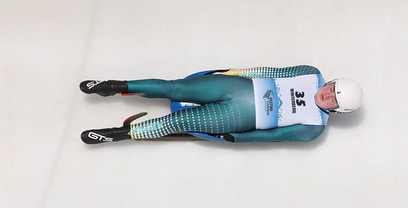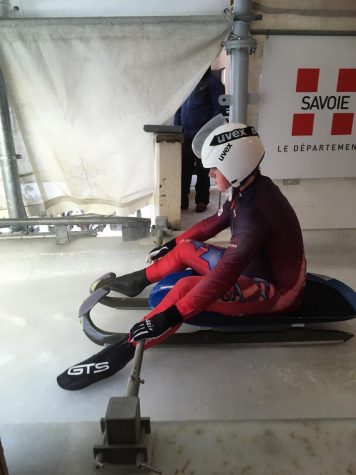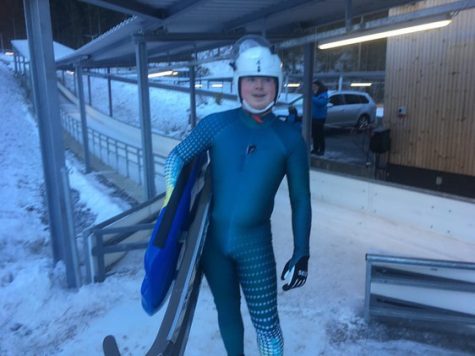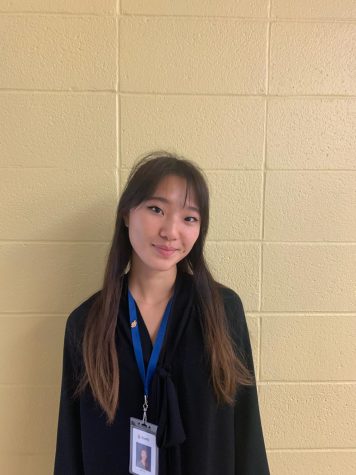Grayson Laugher’s Journey to the 2026 Winter Olympics

March 16, 2023
While THS students recently participated in the annual school Olympics, Grayson Laugher (’23) is aiming for the real games in 2026. Laugher started skiing Black Diamonds at four years old, traveling internationally for luge in his junior year, and has competed in Germany, France, and Austria. He now attends USPA, an online school for traveling athletes.
When did you leave the Tenafly public school system?
It was just after my sophomore year, because junior year was my first year doing international luge, and I couldn’t continue with Tenafly schools ’cause I’d be out for like a month or more at a time, and the school didn’t allow that.
I see. I wanted to interview you about your luge story and experiences. So to get started, what is luge for people who have never heard of it?
It’s a sliding sport where athletes go down a track made of ice on a sled, so they compete for the fastest time.
Isn’t it dangerous? I watched a few of your videos—it goes really fast so I feel like it’d be dangerous.
Yeah, it is pretty dangerous—one of my friends recently broke his wrist doing it, and there was that Georgian athlete in the 2010 Olympics that died. But if you know how to do it, it’s not as dangerous as you’d think.
When and how were you introduced to the sport?
My dad used to do it for fun a long time ago when I was really young. But then in 2017, he took me to the Lake Placid World Cup just to show me what he used to do, and I really wanted to try it. So the next season, we went up to Lake Placid, where I tried it for real. Then, I started in 2018. So that was five years ago… in seventh, eighth grade.

How do you get training for that? Did you originally learn from your dad?
We would go up to Lake Placid and there’s a club that I joined where they would do training on the weekends. So you’d go off, get about six runs in a weekend, and drive back down to Tenafly.
That must be a pretty far journey.
Yeah, it’s about a five, six hour’s drive. So we would do that pretty much every weekend.
So were you committed to it from the start? Like did you know that you had to commit to this?
Pretty much. Like for the first season of it, it was just sort of like, it’s really fun. I want to keep going with it because I like to do it. But then the second season is when I got really serious because that was the season where I was invited to the US National Championships, and I competed in the Empire State Winter Games, which is a small Olympics up in Lake Placid every year. And I won the gold in the youth open. So that had really put me on the track to making it a serious thing.
Can you explain your journey from there?
I placed 8th in the US National Championships, and then in my first season, I placed 14th in my first World Cup. And then I think it was either 16th or 17th in the second one. And I unfortunately crashed in the world championships that season.
So where do you go to compete?
The track is just this really big long concrete structure with turns that go up onto the walls, so there’s a lot of twists and turns in it. And there’s only really a few tracks around the world—there’s the one in China for the Beijing games, the one in Korea for the Pyeongchang games. There’s a few in Germany, a few in Austria, one in Norway for the Lillehammer games. And then there’s one in Canada because they recently pulled down the one in Calgary. So there’s only the Vancouver track left and there’s two in America—in Salt Lake City and Lake Placid.
What goes through your mind as you’re going down the track?
I don’t know. I can never really remember it. I’m sort of in a trance almost where it’s like I start my run and then whatever happens, happens. Like I think about the inputs I need to make, where I need to make them, timing and stuff like that.
Then when you train, what is your focus? Like how do people gain an advantage over others?
It’s about your lines. So you want to have the best lines through the corners; you want to have the best position on the sled. So legs stretched out, head as far back as you can, while still being able to figure out where you are on the track to get the timing of everything correctly. So, a lot of people try out different lines and different positions—different parts on the sled even—just to see if it’ll give them that competitive edge.
I see. What’s your favorite part about luge?
Probably the adrenaline rush of it; it’s like 70 miles an hour at the faster end of it.
Is there a way to stop? Is there a way to break or is it kind of like full send?
Not really in the track; you can put your feet down and that’ll slow you down a little bit, but if you really want to break, that happens at the end where you sit up and you pick up the front of your sled so you’re essentially dragging the back of the sled behind you like a break. That’s really how we stop.
What do you think is the most challenging part?
Hm, I don’t know. It’s probably just getting the technique of it right. Like you need to know all the tracks; you need to know your position; you need to stay really relaxed. And that was the hardest part for me for a while—just not being very tense on the sled and really relaxing and getting my shoulders back.

That’s difficult when you’re going so fast—it’s natural instinct too.
Yeah, especially like if it’s on a track you’re not good with. You get really nervous and the immediate response is just to tense up and brace for things. But you really need to do the opposite. Relax, get your shoulders back, ’cause that’ll move the pressure on the sled and it’ll help you stay controlled.
Yeah. What is your favorite track? Do you have one?
Winterberg in Germany. It is one of the faster tracks, and it’s where I set my personal fastest speed of 128 kilometers an hour, which is 79 miles an hour. And it’s just this really fast, flowy track, and I’m really comfortable on it. So, it’s one of the only tracks I can really, like, relax on and get those good clean runs in.
And my final question for you is: where do you see yourself in the future? Do you see yourself pursuing it professionally?
I don’t really see myself going much further after [college] because it’s a very time-intensive sport. And so by that point, I’ll have to face the “real world” and have a job and everything. I don’t think I could really balance that with luge at the same time. Seeing as some of the athletes that continue it out of college and into their older years, a lot of what they do, they’ll pick up part-time jobs in the off-season to get the money to do it and then they’ll really focus on it during the winter, but I don’t really see myself doing that.
Although Grayson does not see himself pursuing luge professionally, he has his mind set on the 2026 Winter Olympics in Cortina, Italy, which is his ultimate dream. You can follow him along in his luge journey on Instagram at Grayson_Laugher_Luge.
















































































































































